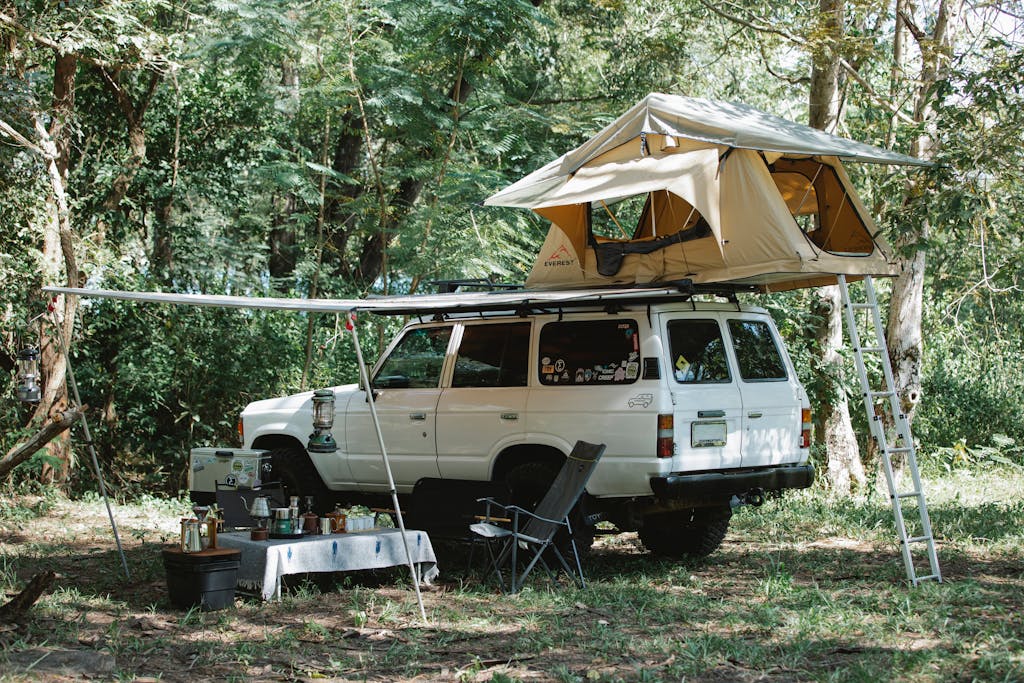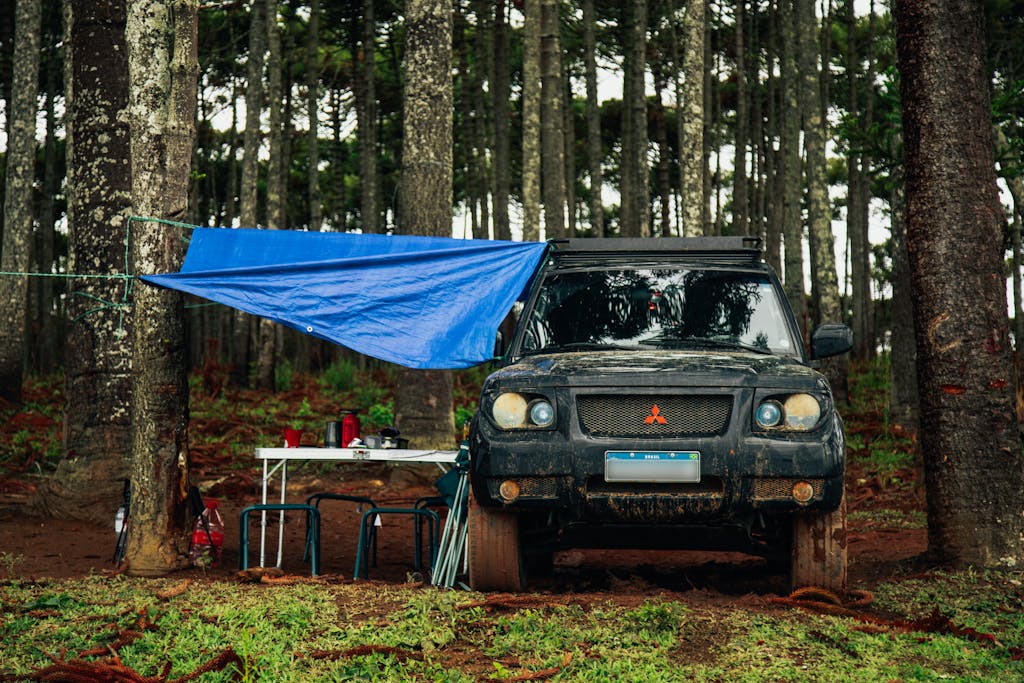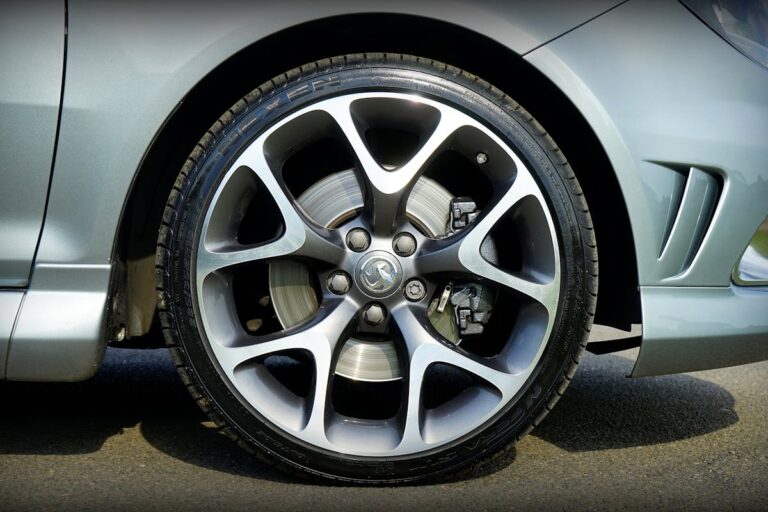How Do You Find Designated Car Camping Spots?
Finding designated car camping spots can seem formidable, yet with the right approach, it becomes an engaging exploration. Online maps and resources provide essential details, while camping apps offer real-time updates. National and state park guidelines further clarify options. Local visitor centers and ranger stations serve as valuable information hubs. Experienced campers and social media communities share recommendations. But, what hidden gems might these resources reveal?
Explore Online Maps and Resources
When planning a car camping trip, utilizing online maps and resources can greatly enhance the experience by providing valuable information and insights. One begins by researching relevant websites dedicated to outdoor adventures and camping. These websites often offer detailed maps indicating designated car camping spots, complete with amenities and regulations. By identifying reputable online sources, such as government park websites or established camping forums, individuals can access up-to-date information on location availability, seasonal closures, and user reviews. These platforms also offer the opportunity to view satellite images and terrain features, helping campers visualize their potential sites. With accurate data at one’s fingertips, campers can make informed decisions, ensuring a seamless and enjoyable outdoor adventure while minimizing unexpected surprises.
Utilize Camping Apps
Camping apps have revolutionized the way adventurers discover designated car camping spots by offering a wealth of information and convenience at their fingertips. Popular apps like Campendium and iOverlander provide exhaustive features such as real-time availability, user reviews, and GPS navigation, enhancing the overall camping experience. By examining user feedback and app functionalities, individuals can make informed decisions that cater to their camping preferences and needs.
Popular Camping Apps
For outdoor enthusiasts seeking to enhance their camping experience, popular camping apps have become indispensable tools. These digital resources offer a wide range of camping spots features, allowing users to discover designated car camping locations with ease. Apps like Hipcamp, The Dyrt, and Campendium stand out for their comprehensive databases and user-friendly interfaces. App usability factors are critical, as they guarantee that finding a perfect site is both efficient and enjoyable. These apps provide information on campsite amenities, user reviews, and booking availability, empowering campers to make informed decisions. With GPS integration and offline access, users can plan trips without connectivity concerns. Robust search filters further augment the user experience, making these apps a vital part of modern camping adventures.
App Features Overview
Understanding the features of camping apps is key to maximizing their potential for a seamless outdoor adventure. When selecting an app, users should consider app selection criteria such as user-friendliness, offline maps, and the accuracy of campsite data. Inclusive apps often provide filters for amenities, allowing campers to tailor their search based on personal preferences. Effective app usage tips include taking advantage of real-time updates and community reviews to enhance decision-making. Some apps even feature integrated GPS navigation to guide users directly to their chosen sites. Additionally, look for apps that offer weather forecasts and safety alerts, which are invaluable for planning and preparation. By focusing on these features, campers can enhance their experience and find the ideal designated car camping spots.
User Experience Insights
The digital transformation of outdoor exploration is vividly illustrated through camping apps, which have redefined the user experience by offering a plethora of tools that cater to a variety of camper needs. These apps leverage user feedback analysis to continuously refine their features, ensuring that they align with the dynamic preferences of their audience. Usability considerations are paramount, as intuitive interfaces enhance the overall satisfaction and ease of navigation for users seeking designated car camping spots. Camping apps often integrate real-time data, user reviews, and detailed maps, transforming the planning process into a seamless experience. By focusing on user-friendly design and functionality, these platforms empower campers to make informed decisions, maximizing both enjoyment and convenience during their outdoor adventures.
Research National and State Parks
Exploring national and state parks for car camping requires understanding the intricacies of park reservation systems and camping regulations. Each park may have its own guidelines and booking processes, often available online, which help guarantee that visitors secure their desired camping spots. Familiarity with these systems not only enhances the camping experience but also certifies compliance with environmental and safety protocols.
Park Reservation Systems
Maneuvering the intricacies of park reservation systems is imperative for those planning a car camping adventure in national and state parks. With increasing visitor numbers, securing a campsite often requires advance planning through online reservation platforms. These platforms facilitate the booking process, allowing campers to view available sites and make reservations from the comfort of their homes. Additionally, understanding seasonal park pass requirements is vital, as some parks mandate these passes during peak seasons to regulate visitor numbers and preserve natural resources. Campers should check individual park websites for specific pass requirements and availability. Staying informed about reservation policies guarantees a seamless experience, maximizing the enjoyment of outdoor adventures while supporting sustainable park management practices.
Camping Regulations Overview
Understanding park reservation systems is only part of the preparation required for a successful car camping trip; awareness of camping regulations is equally important. National and state parks enforce specific rules to manage campsite density and minimize environmental impact. These regulations often dictate campsite locations, group sizes, and permitted activities. For instance, many parks implement a “Leave No Trace” policy to preserve natural habitats, requiring campers to pack out all trash. In addition, some parks limit the number of vehicles per site to reduce congestion and protect wildlife corridors. Compliance with fire restrictions is essential to prevent wildfires, especially in areas prone to dry conditions. By adhering to these guidelines, campers contribute to the sustainability of these cherished outdoor spaces.

Visit Local Visitor Centers
While setting out on a car camping adventure, one of the most valuable resources often overlooked is the local visitor center. These centers serve as a hub of information, offering insights into designated camping spots and local attractions. By visiting a visitor center, travelers can gather details not always available online, complementing their research from tourism websites. Here, knowledgeable staff can provide maps, guidelines, and current conditions that enhance the camping experience. Engaging with these centers allows campers to connect with the local community, gaining insider tips on hidden gems. Additionally, visitor centers often host displays on local culture and history, enriching the overall journey. Taking the time to visit before heading out can greatly impact the quality of a camping trip.
Check With Ranger Stations
How can travelers guarantee their safety and compliance with local regulations when venturing on a car camping expedition? One effective method is to consult local authorities at ranger stations. These hubs are treasure troves of information, offering valuable insights into the camping landscape. By visiting ranger stations, travelers can inquire about designated areas for car camping, ensuring they choose sites that adhere to regulations and ecological guidelines. Ranger stations are staffed by knowledgeable personnel who can provide maps, updates on weather conditions, and information on potential hazards. These interactions can help travelers avoid fines and preserve the natural environment. By taking the time to engage with ranger stations, campers not only enhance their trip’s safety but also contribute to sustainable camping practices.
Seek Recommendations From Experienced Campers
Why venture into the unknown when the wisdom of seasoned campers is readily available? Experienced campers often possess invaluable insights into locating designated car camping spots. By tapping into their wealth of knowledge, one can research local knowledge that might not be found in guidebooks or online maps. Veterans of the camping community often have firsthand experience with hidden gems and can offer tips on amenities, regulations, and conducive times to visit. To capitalize on this resource, it is crucial to seek community advice through local camping clubs, outdoor meetups, or even casual conversations at campgrounds. Engaging with those who have a passion for the outdoors guarantees that one gains practical, reliable information, enhancing the overall camping experience and guiding adventurers to ideal locations.
Investigate Social Media Groups and Forums
In the digital age, social media groups and forums have become invaluable resources for discovering designated car camping spots. By evaluating online discussion boards, enthusiasts can access a wealth of firsthand experiences and insights shared by fellow campers. These platforms often host vibrant communities where members exchange tips on hidden gems and popular locations alike. Additionally, monitoring social media hashtags related to car camping can reveal trending destinations and user reviews. Engaging with these digital communities provides a dynamic way to gather current information and connect with like-minded adventurers. Forums and groups also allow users to ask specific questions, ensuring they obtain targeted advice. Consequently, social media serves as an essential tool for anyone seeking the perfect car camping experience.
Understand Permits and Regulations
Maneuvering the intricacies of permits and regulations is indispensable for a seamless car camping experience. Understanding permit requirements ensures campers are legally compliant and helps protect the natural environment. Each designated camping spot may have specific regulations, often detailed by local authorities or park management. These stipulations might include duration limits or restrictions on campfire usage. Resource availability is a vital consideration, as some locations may offer limited facilities or demand self-sufficiency with respect to water and waste management. Checking official websites or contacting local agencies can provide up-to-date information on permits and regulations, helping campers avoid fines and preserve the integrity of camping areas. Thorough research in advance guarantees both compliance and an enjoyable outdoor adventure.
Consider Proximity to Amenities and Attractions
Once campers have a firm grasp of the necessary permits and regulations, the next consideration is the proximity of their camping spot to amenities and attractions. Selecting a site close to desirable amenities can enhance the camping experience substantially. Campers should consider proximity to dining options, especially if they plan to explore local cuisine or need a break from campfire cooking. In addition, proximity to hiking trails is crucial for those keen to explore nature’s beauty and engage in outdoor activities. Access to nearby trails can offer varied scenic adventures and make the camping trip more rewarding. Additionally, being near other attractions such as lakes, historical sites, or visitor centers can enrich the overall outdoor experience, providing both convenience and enjoyment.
Frequently Asked Questions
Can I Camp in Undesignated Spots if Designated Ones Are Full?
When designated spots are full, dispersed camping options may be available, but campers must respect private property restrictions. It is essential to research local regulations, ensuring camping is allowed in undesignated areas while minimizing environmental impact.
How Do I Identify a Designated Car Camping Spot?
To identify a designated car camping spot, one should scout locations by consulting maps. These maps often highlight official camping areas, providing essential details about amenities and regulations, ensuring a well-planned and rule-abiding camping experience.
What Should I Do if I Encounter Wildlife While Camping?
In the event of encountering wildlife while camping, one should avoid approaching wildlife and guarantee food is secured properly. This minimizes wildlife attraction to campsites, maintaining both camper safety and the natural behavior of the animals.
Are Fires Permitted at All Designated Car Camping Spots?
Fire restrictions vary by location and season at designated car camping spots. Campers should verify local regulations to determine if fires are permitted, often only in designated fire pits, ensuring safety and environmental preservation.
What Are the Common Amenities at Designated Car Camping Spots?
Designated car camping spots often provide common amenities like shower facilities and potable water access. These conveniences enhance the camping experience by ensuring hygiene and hydration, making campsites more comfortable and attractive for travelers seeking outdoor adventures.



